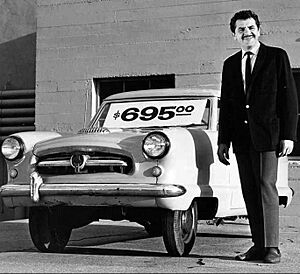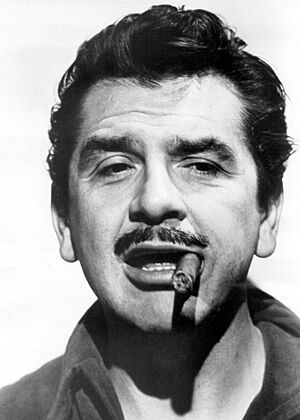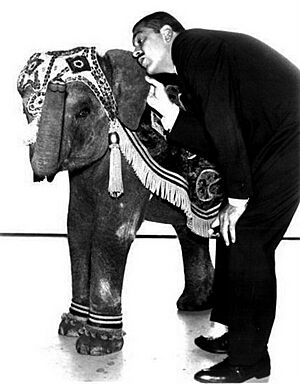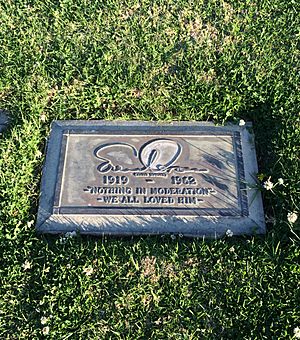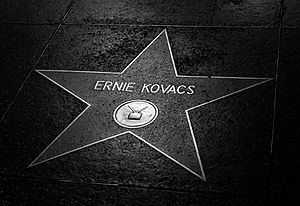Ernie Kovacs facts for kids
Quick facts for kids Ernie Kovacs |
|
|---|---|
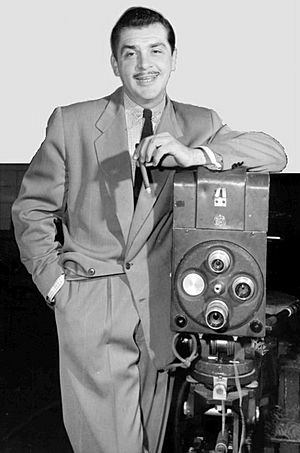
Kovacs on the set of his television show in 1956
|
|
| Birth name | Ernest Edward Kovacs |
| Born | January 23, 1919 Trenton, New Jersey, U.S. |
| Died | January 13, 1962 (aged 42) Los Angeles, California, U.S. |
| Resting place | Forest Lawn Memorial Park, Hollywood Hills |
| Medium |
|
| Years active | 1941–1962 |
| Genres |
|
| Spouse |
Bette Lee Wilcox
(m. 1945; div. 1952) |
| Children | 3 |
| Relative(s) | Bill Lancaster (son-in-law) |
Ernest Edward Kovacs (born January 23, 1919 – died January 13, 1962) was a famous American comedian, actor, and writer. He was known for his unique and experimental style of comedy on television.
Ernie Kovacs's creative and often surprising comedy greatly influenced many TV shows and comedians for years after he passed away. Famous people and shows like Johnny Carson, Saturday Night Live, Monty Python's Flying Circus, Jim Henson, and Sesame Street have said he inspired them. Chevy Chase even thanked Kovacs when he won an Emmy award for Saturday Night Live.
Kovacs and his wife, Edie Adams, were nominated for Emmy awards in 1957. However, his amazing talent was officially recognized mostly after his death. He received an Emmy for Outstanding Electronic Camera Work and a Directors' Guild award shortly after his accident. Years later, he was inducted into the Academy of Television Arts & Sciences Hall of Fame. Kovacs also has a star on the Hollywood Walk of Fame for his work in television. A museum exhibit called The Vision of Ernie Kovacs celebrated his work. A famous TV critic, William Henry III, called Kovacs "television's first significant video artist."
Contents
Ernie Kovacs's Early Life and Career
Ernie Kovacs was born in Trenton, New Jersey. His father, Andrew John Kovacs, came from Hungary. The family lived in a large mansion in Trenton.
Even though he wasn't a great student, Ernie was inspired by his drama teacher, Harold Van Kirk, at Trenton Central High School. With Van Kirk's help, he received a scholarship to the American Academy of Dramatic Arts in 1937. During this time, he watched many "Grade B" movies, which cost only ten cents. These movies later influenced his comedy.
In 1939, while working in Vermont, Kovacs became very ill with pneumonia. He spent a year and a half in hospitals. During this time, he entertained doctors and patients with his funny acts, and his comedic skills grew. He also developed a love for classical music. After leaving the hospital, Kovacs returned to Trenton and began working as a cigar salesman.
His first paid job in entertainment was in 1941 as an announcer for a radio station in Trenton called WTTM. He worked there for nine years, becoming the director of special events. In this role, he did unusual things like pretending to be almost run over by a train or broadcasting from a plane's cockpit after taking flying lessons. He also wrote a newspaper column called "Kovacs Unlimited."
Starting in Television
Ernie Kovacs got his first television job in January 1950 at NBC's Philadelphia station, WPTZ. He showed up for his audition wearing a barrel and shorts! He hosted several shows, including Pick Your Ideal and cooking shows like Now You're Cooking. Once, when a guest chef didn't arrive, Kovacs made "Eggs Scavok" (Kovacs spelled backward) and seasoned them with ashes from his cigar. These shows led him to host Three to Get Ready, named after the station's channel 3.
Three to Get Ready started in November 1950 and was very new because it was the first regular early morning show (7–9 am) in a big city. Before this, people thought no one would watch TV so early. Kovacs made the show unique. If rain was in the forecast, he might pour water on the person reading the weather! He also had funny guests, like goats auditioning for a play. He even went outside the studio for skits, like running through a restaurant in a gorilla suit. Despite its popularity, the show's prop budget was only $15 a week. Once, Kovacs asked viewers to send unwanted items to the station, and they filled the lobby!
One character who inspired many gifts was Howard, the World's Strongest Ant, even though no one ever saw him. Howard received over 30,000 gifts from viewers, including a mink-lined swimming pool! Kovacs also started a fan club called the Early Eyeball Fraternal & Marching Society (EEFMS). The success of Three to Get Ready showed that people did watch early morning TV, which helped inspire NBC to create The Today Show.
In early 1952, Kovacs also hosted Kovacs on the Corner, where he walked through an imaginary neighborhood talking to characters like Pete the Cop. This show also had unique segments, like "Swap Time," where viewers could trade items live on air. Both Kovacs on the Corner and Three to Get Ready ended in March 1952. Kovacs then moved to WCBS-TV in New York for new shows.
Creative Visual Comedy and Characters
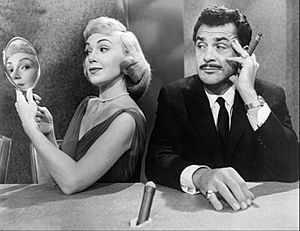
At WPTZ, Kovacs started using his famous ad-libbed and experimental style. He used video effects, like superimposing images, reversing colors, and quick blackouts. He often broke the "fourth wall", meaning his cameras showed things outside the usual show set, like crew members. Kovacs also liked talking to the off-camera crew and even introduced parts of his shows from the control room. He often used unexpected things that happened during the show as part of his comedy.
Kovacs helped create camera tricks that are still used today. For example, his character Eugene would sit at a table, and his lunch items would mysteriously roll down the table into another person's lap. When Kovacs poured milk, it seemed to flow in an unusual direction. The secret was using a tilted set in front of a camera tilted at the same angle.
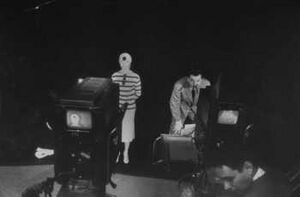
He was always looking for new ways to create visual effects, even using simple, homemade methods. He once made a kaleidoscope from a toilet paper roll and attached it to a camera lens to create abstract images set to music. Another trick involved him sitting in an easy chair underwater, reading a newspaper, and somehow blowing out a puff of white smoke. The "smoke" was actually a small amount of milk he held in his mouth!

One special effect made it look like he could see through his assistant, Barbara Loden's, head. This was done by placing a black patch on Loden's head against a black background. One camera focused on her, and a second camera photographed Kovacs. He used a studio monitor to position himself perfectly so his eye appeared to be in a hole in her head.
Kovacs also created routines like an all-gorilla version of Swan Lake and a poker game set to Beethoven's Fifth Symphony. His "Silent Show" featured Eugene, a character who interacted with the world using only music and sound effects. He also made parodies of TV commercials and had musical segments where everyday items, like kitchen appliances, moved in sync to music. A popular recurring skit was The Nairobi Trio, three ape-like characters in derby hats who mimed mechanically to the tune of "Solfeggio."
Kovacs used both long sketches and short, quick jokes called blackout gags. Some of these could be expensive, like his famous used-car salesman routine where a car fell through a breakaway floor, which cost $12,000 for just six seconds! He was also one of the first comedians to use funny fake credits and comments during his shows.
Kovacs reportedly didn't like performing in front of a live audience. He found them distracting, and they often didn't understand his complex visual jokes and special effects, which were best seen on studio monitors.
Like many comedians, Kovacs had a group of recurring characters. Besides the silent "Eugene," his most famous characters included the lisping poet Percy Dovetonsils and the German radio announcer Wolfgang von Sauerbraten. Mr. Question Man, who answered viewer questions, was a funny take on an old radio show. Other characters included horror show host Auntie Gruesome and the bumbling magician Matzoh Heppelwhite.
Kovacs often made fun of popular radio and television shows. In April 1954, he started a late-night talk show, The Ernie Kovacs Show, on the DuMont Television Network. He often had famous guests.
Kovacs's television shows included Three to Get Ready (1950–1952), It's Time for Ernie (1951), Ernie in Kovacsland (1951), The Ernie Kovacs Show (1952–1956), and he even filled in as host for The Tonight Show (1956–1957). He also hosted game shows like Take a Good Look (1959–1961) and a show called Silents Please, which showed silent movies with serious discussions.
Kovacs was briefly a celebrity panelist on What's My Line?, a game show where panelists guessed a guest's job. He didn't take it very seriously and often asked funny, silly questions instead of real ones. For example, when the mystery guest was Henry J. Kaiser, whose name was linked to a car brand, Kovacs asked, "Are you – and this is just a wild guess – but are you Abraham Lincoln?" (referring to the Lincoln car). His time on the show ended when he admitted in an interview that he missed the show when he wanted to go out for dinner.
TV Specials
Ernie Kovacs also created several television specials, including the famous Silent Show (1957). This was the first all-pantomime (no talking) prime-time network program. It featured his character, Eugene, a mute, Charlie Chaplin-like figure, and was full of surreal visual jokes. The special was a big hit, earning Kovacs his first movie offer and a cover story in Life magazine. In 1961, Kovacs and his co-director, Joe Behar, won an award for a second version of this program.
A series of monthly half-hour specials for ABC in 1961–1962 are often considered his best TV work. These shows used new editing and special effects techniques and won a 1962 Emmy Award. Kovacs's last ABC special was shown after his death, on January 23, 1962.
The Dutch Masters cigar company sponsored many of Kovacs's TV projects. They gave him complete creative freedom to make their commercials. He created a series of non-speaking commercials for Dutch Masters that were praised by critics and viewers.
Even though critics loved his work, Kovacs's shows rarely had very high ratings. The Museum of Broadcast Communications said that Ernie Kovacs might not fit on television today because he was "too zany, too unrestrained, too undisciplined."
However, other shows became very successful by using parts of Kovacs's style. Rowan & Martin's Laugh-In, a popular TV series, often used the quick blackout gags and surreal humor that Kovacs was known for.
The Music Man
Kovacs was also known for his interesting taste in music. His main theme song was "Oriental Blues." He often used the German song "Mack the Knife" for his quick blackout routines. The song "Solfeggio" became famous with his The Nairobi Trio characters.
His wife, Edie Adams, remembered that when Kovacs first heard "Solfeggio," he immediately knew he wanted to create a music-box-like trio that moved to the tune.
Kovacs also used an unusual version of "Sentimental Journey" by Juan García Esquivel. He matched it with a video of an empty office where items like pencil sharpeners and water coolers came to life and moved to the music. This was a very detailed project, with Kovacs writing a four-page memo explaining exactly what needed to be done.
He often used classical music as background for his silent skits or abstract visual routines. Some pieces he used included music by Béla Bartók, Sergei Prokofiev, Igor Stravinsky, and Richard Strauss. He was perhaps best known for using Joseph Haydn's "String Quartet, Opus 3, Number 5" for commercials he made for Dutch Masters cigars.
For a show called Kovacs on Music, he started by saying, "I have never really understood classical music, so I would like to take this opportunity to explain it to others." He then presented a gorilla version of Swan Lake and other funny sketches.
Kovacs also hosted a jazz album in 1957 to help the American Cancer Society. It featured famous jazz artists like Duke Ellington.
Books and Writing
Kovacs wrote a novel called Zoomar: A Sophisticated Novel about Love and TV (1957). He wrote the book in just 13 days! The title came from the Zoomar brand zoom lenses used on TV cameras.
His only other published book was How to Talk at Gin, which came out after his death in 1962. He also wrote for Mad magazine, his favorite humor magazine, creating features like "Strangely Believe It!" (a parody of Ripley's Believe It or Not!).
Guest Appearances on TV and in Films
Ernie Kovacs and Edie Adams appeared as guest stars on the very last episode of The Lucille Ball-Desi Arnaz Show in 1960. Kovacs also acted in other TV shows, like General Electric Theater, where he played a detective with an amazing sense of smell.
Kovacs also found success in Hollywood as an actor in films. He often played military officers in movies like Operation Mad Ball and Our Man in Havana. He received good reviews for his roles, such as a writer in Bell, Book and Candle and a railroad company head in It Happened to Jane. In 1960, he played a base commander in Wake Me When It's Over and a con man in North to Alaska. His favorite film role was reportedly in Five Golden Hours (1961). His last movie, Sail a Crooked Ship, was released one month before he died.
Ernie Kovacs's Family Life
First Marriage and Children
Kovacs married his first wife, Bette Wilcox, in 1945. When their marriage ended, he fought hard to gain custody of their two daughters, Elizabeth ("Bette") and Kip Raleigh ("Kippie"). The court decided that Kovacs should have full custody, which was very unusual at the time. His former wife later tried to regain custody after his death. However, both daughters, Bette and Kippie, told the court they wanted to stay with their stepmother, Edie Adams, whom they called "Mommy." The court agreed, and the girls remained with Edie, which made everyone very happy.
Second Marriage to Edie Adams
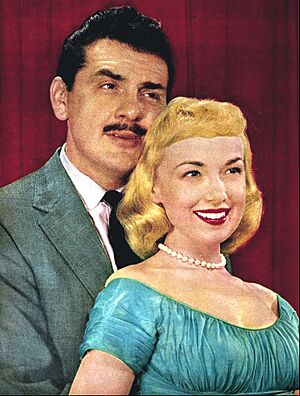
Kovacs met Edie Adams in 1951 when she was hired for his WPTZ show, Three to Get Ready. Edie was a classically trained singer. Kovacs was very taken with her and tried to win her over with creative and romantic gestures, like hiring a mariachi band to serenade her. He even gave her a diamond engagement ring and told her to wear it until she decided.
Edie went on a European cruise to think about it, but after only three days and many phone calls, she returned to say "yes." They got married on September 12, 1954, in Mexico City. The ceremony was in Spanish, which neither of them understood! Edie, who came from a middle-class background, loved Kovacs's unique personality. They stayed together until his death. Edie was a regular partner on his TV shows and was always willing to do whatever he imagined, whether it was singing, doing impressions, or even taking a pie in the face. They had one daughter together, Mia Susan Kovacs, born in 1959.
In 1957, Kovacs moved his family to California. He realized he was working too much in New York and wanted more time for Edie and his daughters. He said he knew it was time for a change when he was telling his girls a bedtime story and found himself thinking of using it for a show instead.
Ernie Kovacs's Death
In the early morning of January 13, 1962, Ernie Kovacs was driving his Chevrolet Corvair station wagon in West Los Angeles. He lost control of the car while turning quickly and crashed into a power pole. He died almost immediately from his injuries.
A simple service was held for Kovacs. Many famous people attended, including Jack Lemmon, Frank Sinatra, Dean Martin, Billy Wilder, George Burns, Groucho Marx, and Jack Benny. He is buried in Forest Lawn-Hollywood Hills Cemetery in Los Angeles. His epitaph says, "Nothing in moderation—We all loved him."
Preserving Ernie Kovacs's Work
Most of Ernie Kovacs's early television shows were performed live, and not many recordings of them still exist. Some videotapes of his ABC specials were saved. After Kovacs's death, his wife, Edie Adams, found out that some TV networks were erasing and reusing tapes of his shows. She worked hard to buy the rights to the surviving footage of his work.
Edie Adams used some of the videotapes she bought for a 1968 ABC television special called The Comedy of Ernie Kovacs. Most of Kovacs's saved work is available for people to study at the University of California, Los Angeles Library.
A 1984 TV movie, Ernie Kovacs: Between the Laughter, helped bring Kovacs back into public attention. Jeff Goldblum played Kovacs in the movie. Later, PBS stations broadcast compilations of his work called The Best of Ernie Kovacs, narrated by Jack Lemmon. These shows were later released on DVD.
In 2011 and 2012, Shout! Factory released DVD collections of Kovacs's television career, including rare color recordings. In 1961, Kovacs recorded an album of poetry as his character Percy Dovetonsils, but it wasn't released until 2012.
Kovacs was honored after his death by being inducted into the Broadcast Pioneers of Philadelphia's Hall of Fame in 1992.
Partial Filmography
- Operation Mad Ball (1957) as Capt. Paul Lock
- Bell, Book and Candle (1958) as Sidney Redlitch
- It Happened to Jane (1959) as Harry Foster Malone
- Our Man in Havana (1959) as Capt. Segura
- Wake Me When It's Over (1960) as Capt. Charlie Stark
- Strangers When We Meet (1960) as Roger Altar
- North to Alaska (1960) as Frankie Canon
- Pepe (1960) as Immigration Inspector
- Five Golden Hours (1961) as Aldo Bondi
- Sail a Crooked Ship (1961) as Bugsy G. Foglemeyer aka The Captain
See also
 In Spanish: Ernie Kovacs para niños
In Spanish: Ernie Kovacs para niños



